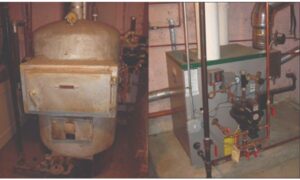CO2 and NO2 were the most common non-compliant indoor air contaminants, followed by particulate matter (PM) and formaldehyde, the most common VOCs.
Reinforcing its commitment towards enabling sustainable buildings and workspaces across the country, GBCI India, India’s foremost authority on sustainability in building design, construction and operations, released a joint research study, “Healthy Workplaces for Healthier People,” in collaboration with Saint-Gobain Research India.
The study assesses the indoor environment in Indian workspaces and the impact it has on building occupants, and highlights the correlation between indoor spaces and occupants’ health and well-being. The study revealed there is considerable room for improvement in Indian offices when it comes to maintaining a healthy indoor environment.
Spanning a pre-pandemic timeframe, the study involved evaluation of 30 offices located in nine Indian cities covering three major climatic zones, and included a mix of green certified and non-certified spaces owned by private and government agencies. Collectively, these offices had occupancy of about 30,000 people 1,500 of whom also participated in an online survey as part of the study. Building data collected from project teams and professionals who work at the buildings along with onsite measurements and inspection and occupant feedback collected through online surveys were all analysed to determine whether the buildings were delivering healthy and comfortable spaces.
The study evaluated important parameters such as indoor air quality, lighting, and access to outdoor views, thermal comfort and acoustics that define workspace quality. Out of the 30 offices studied, only one had all the indoor air contaminants within limits prescribed by standards. Both indoor generated contaminants and those entering from the outdoors were a concern due to the adverse impact they have on occupant health. Carbon dioxide (CO2 ) and nitrogen dioxide (NO2 ) were the most common noncompliant indoor air contaminants, followed by particulate matter (PM) and formaldehyde (CH2 O). Poor lighting and lack of access to good outdoor views from workstations were found to be other prevalent issues.
1,500 employees from the 30 offices studied also participated in an online survey. The aim was to understand how occupants feel about their workspace and how it impacts them. Occupant surveys are usually considered a basis for identifying problem areas and evaluating the indoor environmental quality (IEQ) of a space. However, the findings of the study revealed that critical indoor parameters like air quality and lighting were primarily unnoticeable by occupants. Despite poor lighting and air quality observed, 76 percent of people reported satisfaction with lighting and 68 percent with air quality, highlighting that occupants’ perception does not accurately reflect IEQ performance. This indicates how critical it is to regularly monitor IEQ performance and to educate occupants on its impact on their short and long-term health.
Commenting on the study findings, Mili Majumdar, Managing Director, GBCI India and Senior Vice President, USGBC, said, “We spend most of our lives inside buildings. As such, the ways they are designed, built and operated have a direct effect on our health, not to mention our overall wellbeing and productivity. The pandemic has heightened the need for safe and healthy workspaces and businesses must ensure occupant safety by pursuing and maintaining high quality workplaces.”
Majumdar further added, “The timing couldn’t be better to share the findings of our recent study on the health performance of India’s office buildings, which underscores the impacts of physical surroundings on people. I am hopeful that this study will persuade decision-makers to prioritise workplace health and safety and pursue a people-driven approach to space design and maintenance. Offices have to be spaces where people want to work and where they feel most productive.”
Unnikrishnan AR, Managing Director, Saint-Gobain India Private Limited, Glass Business, added, “Making the world a better home is the purpose with which we at Saint-Gobain have been working with all our stakeholders. Occupier wellbeing and sustainability, during construction and across the building’s lifetime, play incredibly important roles in living up to this purpose. It was, therefore, necessary for us to understand the diverse needs, end uses, climatic conditions, designs and choice of materials to enhance occupant wellbeing and overall sustainability. The ‘Healthy Workplaces for Healthier People’ study was an extensive exercise carried out over a period of three years, with deep data analysis spanning over a year. We are confident that the insights from this study will help us design and implement better and safer workspaces, thereby aiding our pursuit to make the world a better home.”
Findings from the study reveal most offices are unable to maintain a healthy indoor environment. Inadequate design, operation and maintenance practises and building managers’ and occupants’ lack of awareness on IEQ are the reasons behind poor quality indoor environments in most offices.
Unhealthy indoor air: a prominent concern
In 73 percent of the spaces, the levels of three or more contaminants did not meet the prescribed limits. Both indoor-generated contaminants and those entering from outdoors were a concern due to the adverse impact they have on occupant health.
- Only 1 out of the 30 offices studied maintained healthy indoor air quality.
- Carbon dioxide levels, which are generally used to evaluate the ventilation adequacy of any space, were found to be higher than the recommended threshold in 75 percent of the office spaces.
- CO2 sensor-based outdoor air intake was found to be an effective strategy to ensure proper ventilation.
- 67 percent of the offices had NO2 levels higher than the recommended threshold. Chemical filters that can remove NO2 from outdoor air were found in only 10 percent of the spaces.
- The concentration of particulate matter (PM), which is a major health risk in most urban areas of India, was higher than the threshold in 63 percent of spaces and 40 percent of the spaces did not have filters installed to trap fine particulate matter (PM2.5).
- 45 percent of the survey respondents reported experiencing eye irritation, fatigue, dizziness, coughing and other symptoms which can be attributed to poor indoor air quality.
Poor lighting conditions are prevalent
- 64 percent of offices had lighting levels lower than what is recommended.
- Only 10 percent of offices met the standard for equivalent melanopic lux during morning hours. Equivalent melanopic lux is described as a way of measuring the biological effects of light on humans.
- 60 percent of the survey respondents reported problems related to their eyes. Eye strain was the main problem reported, which is due to low lighting conditions.
Access to external views is important for people’s health and well-being
74 percent of people reported no external views or only poor-quality views from their workstations. People with good outdoor views had higher energy levels at the end of the day and reported fewer sleep-related problems than those with poor or no views.
Occupants having no or partial control over temperature set points resulted in thermal discomfort
In most buildings studied, the thermal conditions were controlled centrally by the building management system, and only a few buildings provided complete control to occupants to modify thermal settings. In most cases, only the meeting rooms had a thermostat whose setting could be modified by the occupants. In open office spaces, the facilities team controlled thermostat temperature set points. This led to over-cooled or under-cooled spaces and resulted in occupant discomfort.
The predicted mean vote (PMV) distribution showed that 56percent of the spaces operated on the cooler side of the comfort zone. However, while analysing occupants’ perception with respect to thermal comfort conditions; it was found that comfort perception improved when buildings were on the warmer side of sensation (positive PMV). Putting it simply, while the occupant’s perception indicated a preference for slightly warmer spaces, many spaces were overcooled.
Therefore, operating buildings on the warmer side of the comfort zone will keep occupants happy and also result in significant energy savings.
In 73 percent of spaces, levels of interior background noise were higher than the standard threshold.
- The proximity of HVAC equipment, inadequate noise isolation for equipment rooms and exposed ceilings with open ductwork were the main reasons for high interior noise levels.
- Ceilings treated with acoustics tiles performed best in optimising the echo or reverberation time (RT) in the space.
- Which indoor environmental factors impact occupants the most?
- High levels of nitrogen dioxide in the indoor air, lack of access to good outdoor views and low equivalent melanopic lux levels in the morning hours were the top factors affecting people’s overall happiness with their office environments.
- Main factors linked with occupants feeling fatigued at the end of the day were lack of access to good outdoor views, poor thermal comfort conditions and high levels of indoor background noise.
Can workplace improvements encourage people to lead a healthier life?
The online survey was also collected that was analysed to understand the general trend in occupants’ health, lifestyle and workplace habits. The study revealed:
- 45 percent of the survey respondents reported experiencing eye irritation, fatigue, dizziness, coughing and other symptoms which can be attributed to poor indoor air quality.
- 60 percent of the survey respondents reported problems related to their eyes. Eye strain was the main problem reported, which is due to low lighting conditions.
- 44 percent of survey respondents reported having one or more lifestyle related health issue in the past year and 15 percent reported having more than one health issue.
- As per the survey data, 71 percent of respondents reported getting less than seven hours of average daily sleep, and 37 percent of occupants reported sleep related problems like difficulty falling asleep and not getting enough restful sleep.
- 64 percent respondents reported sitting for 8 to 10 hours daily at their workstation, and only 19 percent took a break every hour.
- 66 percent of the surveyed occupants reported musculoskeletal issues.
While the conversation around the quality of indoor spaces and its effects on occupants is not new, the COVID-19 pandemic has put a spotlight on its importance. The expectations from workplace environments are destined to change in the post-pandemic world. The insights from the “Healthy Workplaces for Healthier People” study will prove useful to company leaders, building owners, office managers, architects and developers in evaluating and improving health performance of existing facilities and planning new projects, as healthy people in healthy places would be imperative to ensure a healthy economy.
Cookie Consent
We use cookies to personalize your experience. By continuing to visit this website you agree to our Terms & Conditions, Privacy Policy and Cookie Policy.















